Page 2 of 612

TABLE OF CONTENTSIndex
2
1-1. Hybrid systemHybrid system ...................... 30
Hybrid system precautions ........................ 35
Energy monitor/ consumption screen ........... 41
Hybrid vehicle driving tips .... 46
1-2. Key information Keys ..................................... 48
1-3. Opening, closing and locking the doors and
trunk
Smart key system................. 51
Wireless remote control ....... 64
Doors.................................... 67
Trunk .................................... 72
1-4. Adjustable components (seats, mirrors,
steering wheel)
Front seats ........................... 76
Rear seats ............................ 79
Head restraints ..................... 81
Seat belts ............................. 83
Steering wheel ..................... 90
Anti-glare inside rear view mirror.......................... 91
Outside rear view mirrors ..... 93 1-5. Opening and closing
the windows and
moon roof
Power windows..................... 95
Moon roof ............................. 98
1-6. Refueling Opening the fuel tank cap .................................... 102
1-7. Theft deterrent system Immobilizer system ............. 106
Alarm .................................. 108
1-8. Safety information Correct driving posture ....... 111
SRS airbags ....................... 113
Front passenger occupant classification system ......... 125
Child restraint systems ....... 131
Installing child restraints ..... 135
2-1. Driving procedures Driving the vehicle .............. 146
Power (ignition) switch........ 157
EV drive mode .................... 165
Hybrid transmission ............ 168
Turn signal lever ................. 170
Parking brake ..................... 172
Horn .................................... 173
1Before driving
2When driving
Page 29 of 612
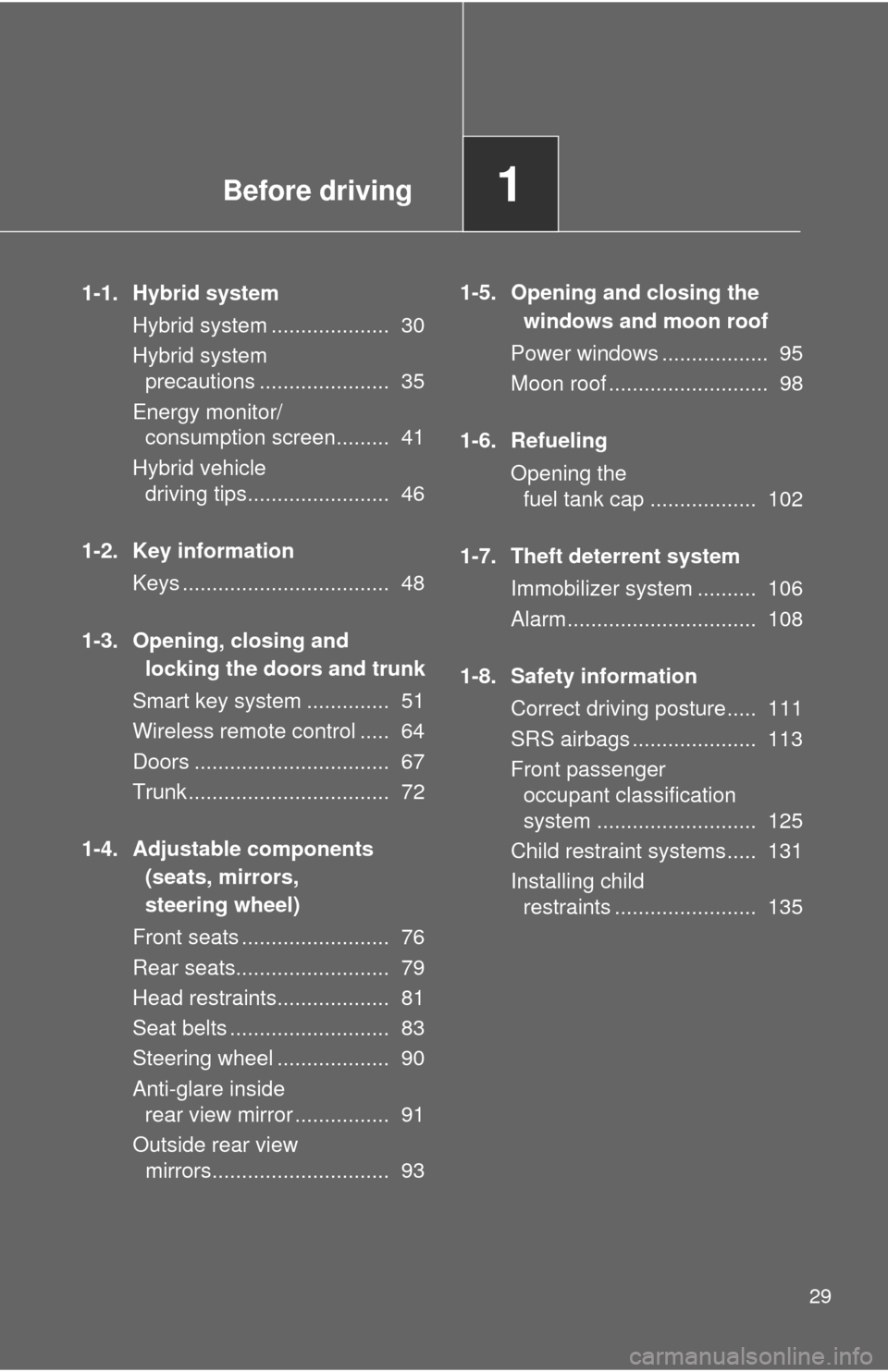
Before driving1
29
1-1. Hybrid systemHybrid system .................... 30
Hybrid system precautions ...................... 35
Energy monitor/ consumption screen......... 41
Hybrid vehicle driving tips........................ 46
1-2. Key information Keys ................................... 48
1-3. Opening, closing and locking the doors and trunk
Smart key system .............. 51
Wireless remote control ..... 64
Doors ................................. 67
Trunk .................................. 72
1-4. Adjustable components (seats, mirrors,
steering wheel)
Front seats ......................... 76
Rear seats.......................... 79
Head restraints................... 81
Seat belts ........................... 83
Steering wheel ................... 90
Anti-glare inside rear view mirror ................ 91
Outside rear view mirrors.............................. 93 1-5. Opening and closing the
windows and moon roof
Power windows .................. 95
Moon roof ........................... 98
1-6. Refueling Opening the fuel tank cap .................. 102
1-7. Theft deterrent system Immobilizer system .......... 106
Alarm................................ 108
1-8. Safety information Correct driving posture..... 111
SRS airbags ..................... 113
Front passenger occupant classification
system ........................... 125
Child restraint systems..... 131
Installing child restraints ........................ 135
Page 102 of 612
102
1-6. Refueling
Opening the fuel tank cap
Perform the following steps to open the fuel tank cap:
■Before refueling the vehicle
Turn the “POWER” switch off and close all the doors and win-
dows.
■ Opening the fuel tank cap
Pull up the opener to open the
fuel filler door.
Turn the fuel tank cap slowly
to open.
Hang the fuel tank cap on the
back of the fuel filler door.
STEP1
STEP2
STEP3
Page 103 of 612
103
1-6. Refueling
1
Before driving
Closing the fuel tank cap
After refueling, turn the fuel tank
cap until you hear a click. Once
the cap is released, it will turn
slightly in the opposite direction.
Page 104 of 612
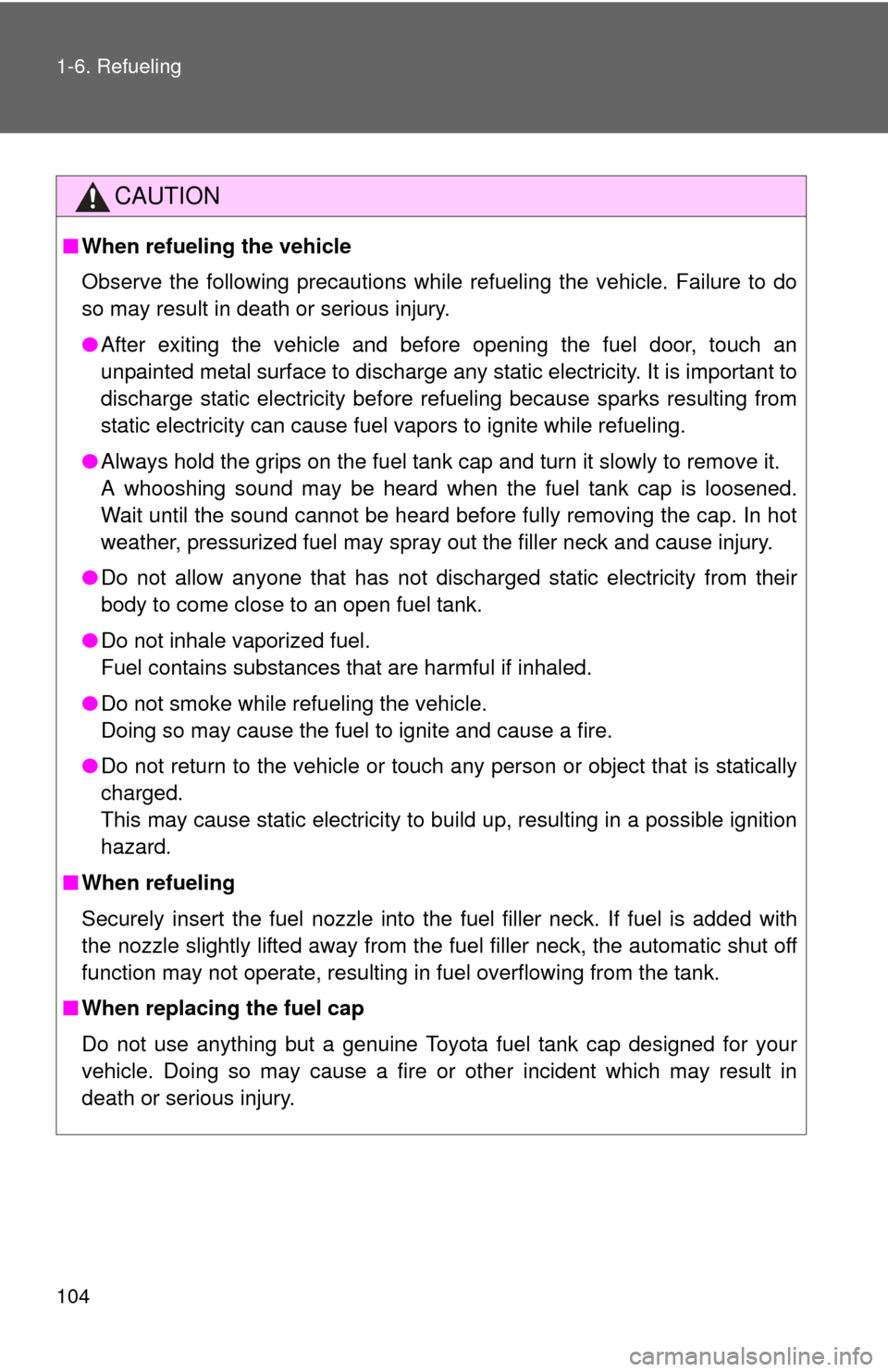
104 1-6. Refueling
CAUTION
■When refueling the vehicle
Observe the following precautions while refueling the vehicle. Failure to do
so may result in death or serious injury.
●After exiting the vehicle and before opening the fuel door, touch an
unpainted metal surface to discharge any static electricity. It is important to
discharge static electricity before refueling because sparks resulting from
static electricity can cause fuel vapors to ignite while refueling.
● Always hold the grips on the fuel tank cap and turn it slowly to remove it.
A whooshing sound may be heard when the fuel tank cap is loosened.
Wait until the sound cannot be heard before fully removing the cap. In hot
weather, pressurized fuel may spray out the filler neck and cause injury.
● Do not allow anyone that has not discharged static electricity from their
body to come close to an open fuel tank.
● Do not inhale vaporized fuel.
Fuel contains substances that are harmful if inhaled.
● Do not smoke while refueling the vehicle.
Doing so may cause the fuel to ignite and cause a fire.
● Do not return to the vehicle or touch any person or object that is statically
charged.
This may cause static electricity to build up, resulting in a possible ignition
hazard.
■ When refueling
Securely insert the fuel nozzle into the fuel filler neck. If fuel is added with
the nozzle slightly lifted away from the fuel filler neck, the automatic shut off
function may not operate, resulting in fuel overflowing from the tank.
■ When replacing the fuel cap
Do not use anything but a genuine Toyota fuel tank cap designed for your
vehicle. Doing so may cause a fire or other incident which may result in
death or serious injury.
Page 224 of 612
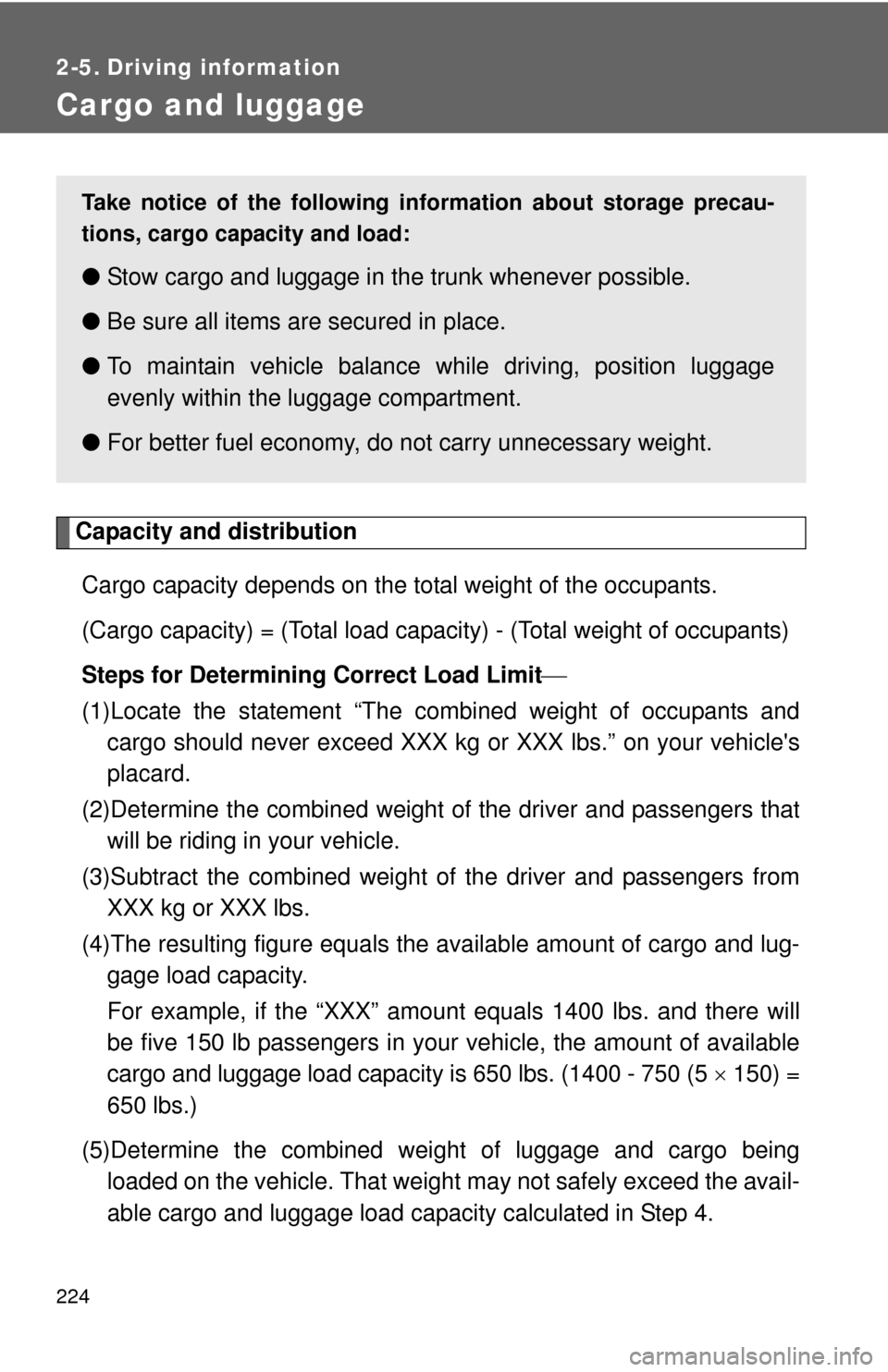
224
2-5. Driving information
Cargo and luggage
Capacity and distributionCargo capacity depends on the total weight of the occupants.
(Cargo capacity) = (Total load capacity) - (Total weight of occupants)
Steps for Determining Correct Load Limit
(1)Locate the statement “The co mbined weight of occupants and
cargo should never exceed XXX kg or XXX lbs.” on your vehicle's
placard.
(2)Determine the combined weight of the driver and passengers that
will be riding in your vehicle.
(3)Subtract the combined weight of the driver and passengers from XXX kg or XXX lbs.
(4)The resulting figure equals the available amount of cargo and lug- gage load capacity.
For example, if the “XXX” amount equals 1400 lbs. and there will
be five 150 lb passengers in your vehicle, the amount of available
cargo and luggage load capacity is 650 lbs. (1400 - 750 (5 150) =
650 lbs.)
(5)Determine the combined weight of luggage and cargo being loaded on the vehicle. That weight may not safely exceed the avail-
able cargo and luggage load capacity calculated in Step 4.
Take notice of the following information about storage precau-
tions, cargo capacity and load:
● Stow cargo and luggage in the trunk whenever possible.
● Be sure all items are secured in place.
● To maintain vehicle balance while driving, position luggage
evenly within the luggage compartment.
● For better fuel economy, do no t carry unnecessary weight.
Page 244 of 612
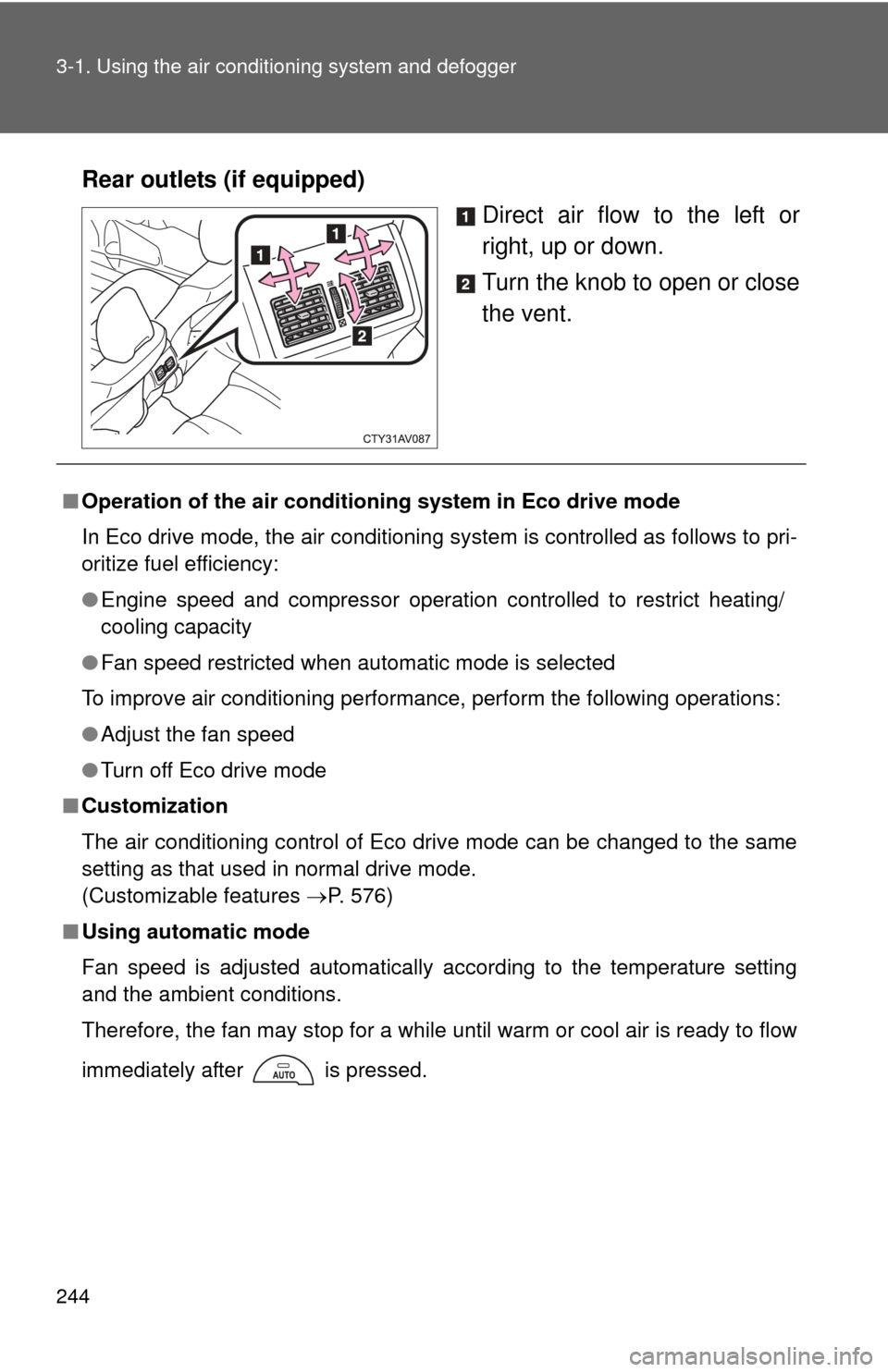
244 3-1. Using the air conditioning system and defogger
Rear outlets (if equipped)
Direct air flow to the left or
right, up or down.
Turn the knob to open or close
the vent.
■Operation of the air conditio ning system in Eco drive mode
In Eco drive mode, the air conditioning system is controlled as follows to pri-
oritize fuel efficiency:
● Engine speed and compressor operation controlled to restrict heating/
cooling capacity
● Fan speed restricted when automatic mode is selected
To improve air conditioning performance, perform the following operations:
● Adjust the fan speed
● Turn off Eco drive mode
■ Customization
The air conditioning control of Eco drive mode can be changed to the same
setting as that used in normal drive mode.
(Customizable features P. 576)
■ Using automatic mode
Fan speed is adjusted automatically according to the temperature setting
and the ambient conditions.
Therefore, the fan may stop for a while until warm or cool air is ready to flow
immediately after is pressed.
Page 422 of 612
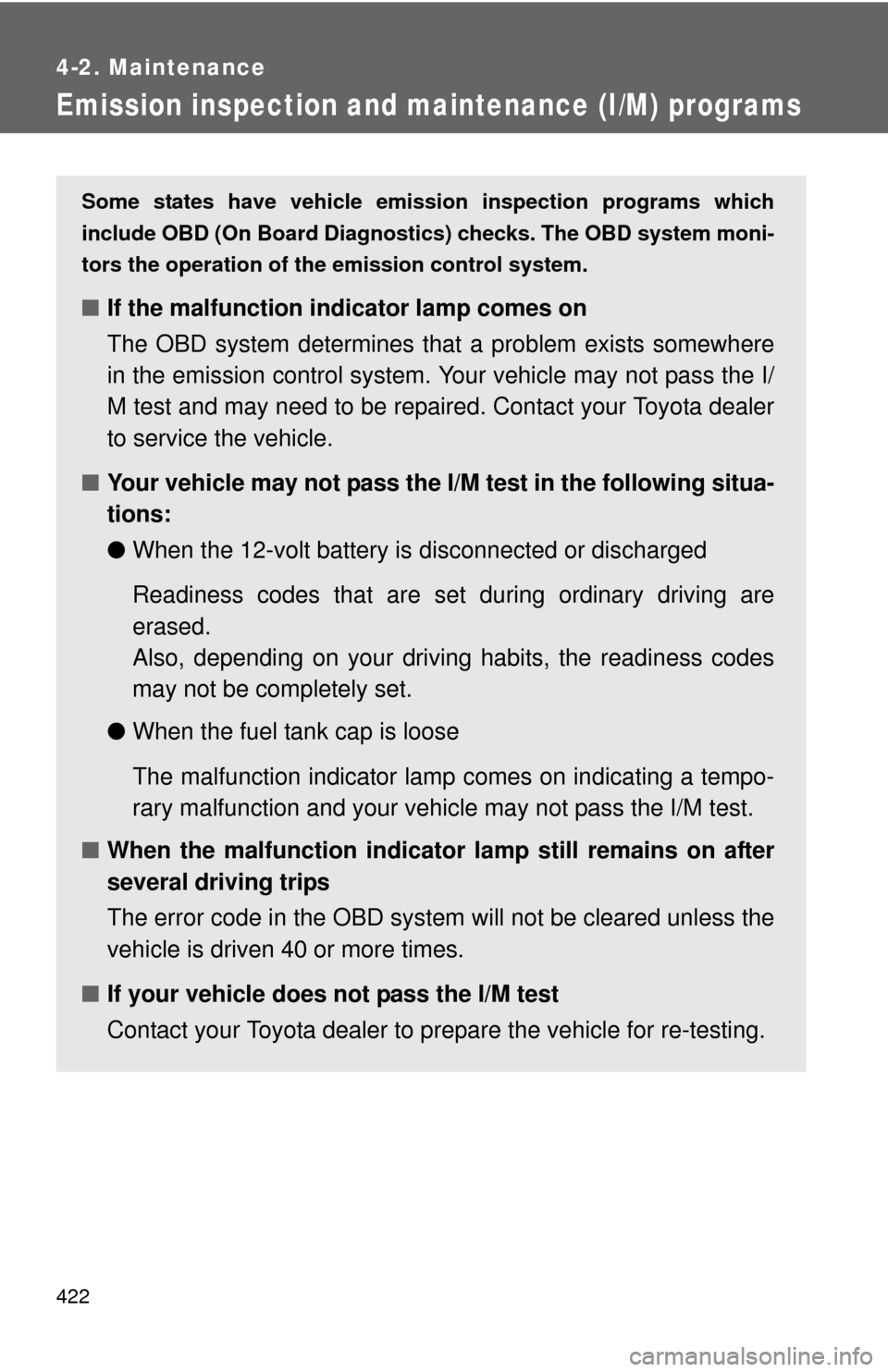
422
4-2. Maintenance
Emission inspection and maintenance (I/M) programs
Some states have vehicle emission inspection programs which
include OBD (On Board Diagnostics) checks. The OBD system moni-
tors the operation of th e emission control system.
■If the malfunction indicator lamp comes on
The OBD system determines that a problem exists somewhere
in the emission control system. Your vehicle may not pass the I/
M test and may need to be repaired. Contact your Toyota dealer
to service the vehicle.
■ Your vehicle may not pass the I/M test in the following situa-
tions:
●When the 12-volt battery is disconnected or discharged
Readiness codes that are se t during ordinary driving are
erased.
Also, depending on your driving habits, the readiness codes
may not be completely set.
● When the fuel tank cap is loose
The malfunction indicator lamp comes on indicating a tempo-
rary malfunction and your vehi cle may not pass the I/M test.
■ When the malfunction indicator lamp still remains on after
several driving trips
The error code in the OBD system will not be cleared unless the
vehicle is driven 40 or more times.
■ If your vehicle does not pass the I/M test
Contact your Toyota dealer to prepare the vehicle for re-testing.